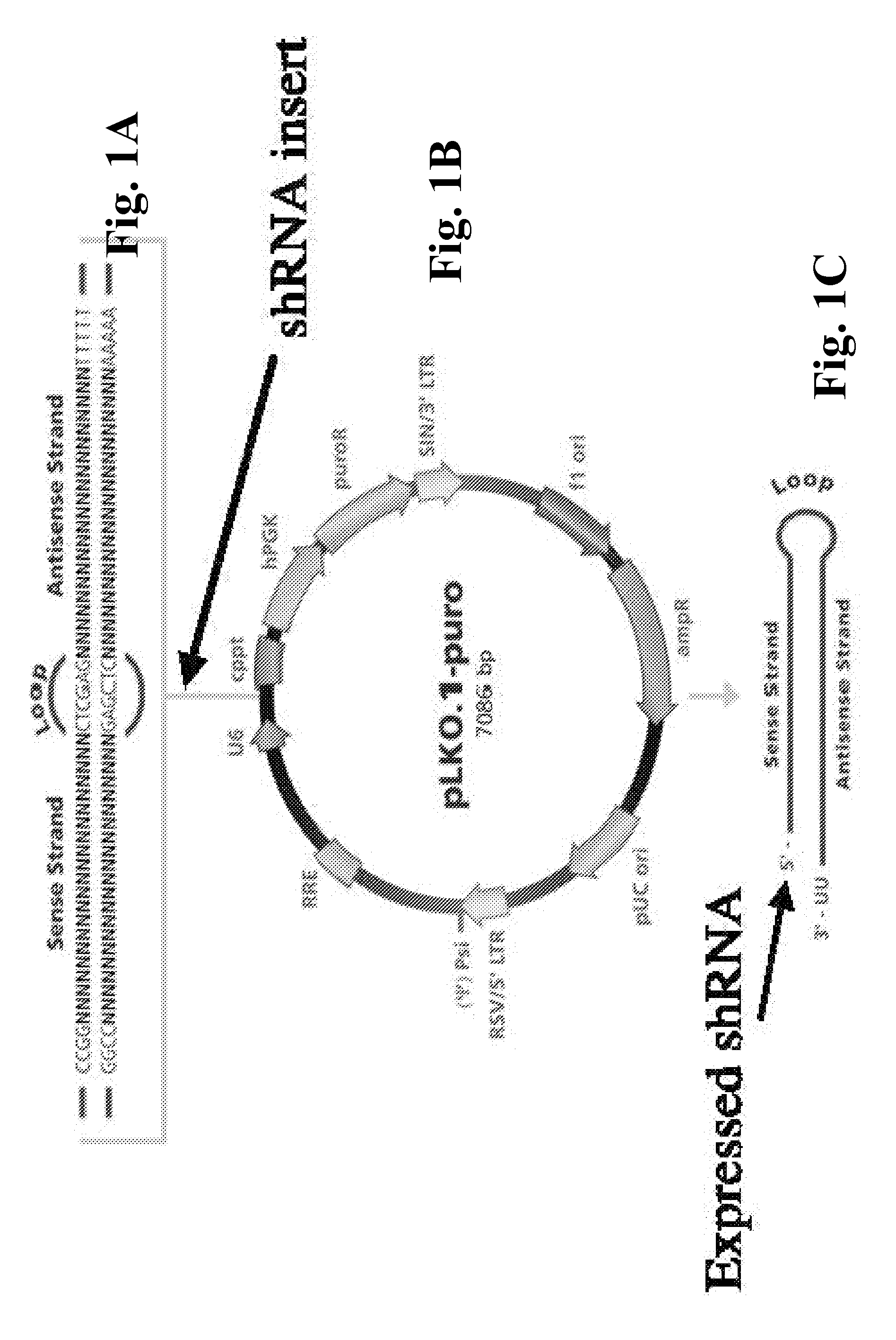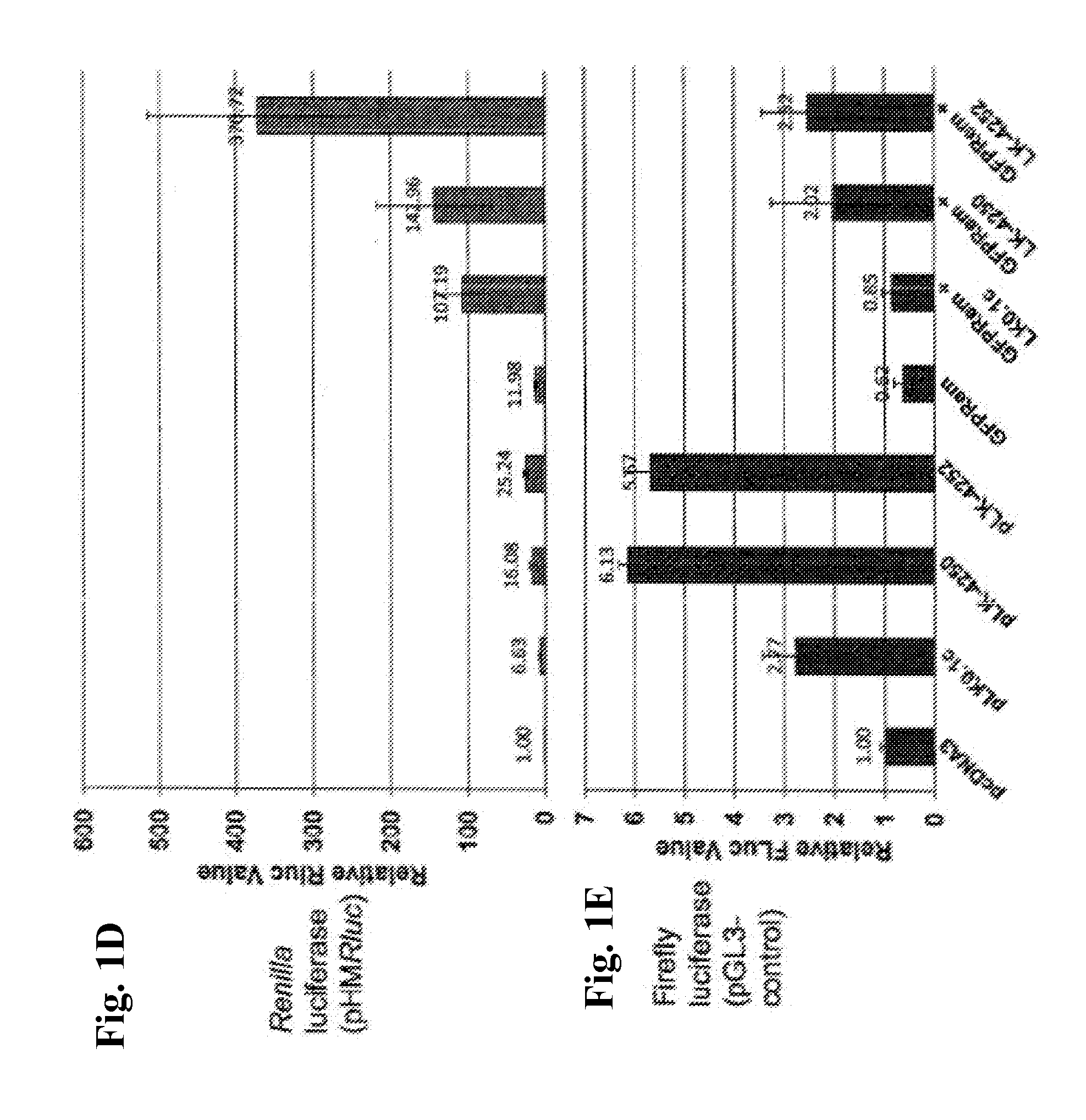Compositions And Methods To Enhance Protein Expression
a technology of protein expression and composition, applied in the field of composition and methods to enhance protein expression, can solve the problem that the expression vector currently used for expressing protein in mammalian cells shows low levels of protein expression
- Summary
- Abstract
- Description
- Claims
- Application Information
AI Technical Summary
Benefits of technology
Problems solved by technology
Method used
Image
Examples
example i
[0268]This Example describes exemplary Materials and Methods used herein for making and using co-transfection vectors of the present inventions.
[0269]pLKO.1 Plasmids. pLKO.1-control (pLKO.1c), pLK-4250 (shRNA TRCN0000004250), and pLK-4252 (shRNA TRCN0000004252) plasmids were obtained from Sigma. ShRNA hairpin sequences are SEQ ID NO:01: CCGGCAACAAGATGAAGAGCACCAACTCGAGTTGGTGCTCTTCATCTTGTTGT TTTT, SEQ ID NO:02: 5′CCGG-CCTAGCCCTTATTGCATTGTT-CTCGAG-AACAATGCAATAAGGGCTAGG-TTTTT3′, SEQ ID NO:03: 5′CCGG-GATGGATGAATTGCAGTTGTT-CTCGAG-AACAACTGCAATTCATCCATC-TTTTT3′, respectively. Target sequences for pLKO.1-control (pLKO.1c), pLK-4250, and pLK-4252 plasmids are pLK-4250 SEQ ID NO:12: CCTAGCCCTTATTGCATTGTT, pLK-4252 SEQ ID NO:13: GATGGATGAATTGCAGTTGTT (valosin containing protein-VCP), respectively. Valosin-containing protein (VCP) or p97 refers to a type II member of AAA+-ATPase family (ATPase p97 shRNA AAA A), (ATPases with multiple cellular activities) having ubiquitin segregase activity.
[0270...
example ii
[0300]This Example describes exemplary Materials and Methods showing the surprising result of super-induction of Rem in a co-transfection system with a lentiviral plasmid expected to at least restore wild-type Rem activity.
[0301]While studying the effect of silencing p97 / VCP on Rem retrotranslocation, pLKO.1-based shRNAs vectors containing shRNAs against p97, and a control shRNA plasmid (see, exemplary pLKO.1-c in FIG. 1B), were purchased and tested for their effectiveness in knocking down the level of p97 / VCP. In silencing assays, #4250 transfection showed a measurable decrease in p97 protein levels in comparison to #4252 and pLKO.1-puro control. A luciferase value of reporter vector co-transfected with an empty vector was set to 1. These plasmids were then tested in co-transfection experiments in 293T cells with a GFPRem expression plasmid for measuring their effect upon the activity of mouse mammary tumor virus (MMTV) Rem, a Rev-like RNA-binding protein. When these experiments in...
example iii
[0302]This Example describes exemplary Materials and Methods showing additional surprising results of super-induction of Rem and other co-transfected genes on expression plasmids in a co-transfection system. Rem activity was measured by co-transfection of the pHMRluc plasmid which requires Rem binding to the Rem-responsive element in the Renilla luciferase transcript.
[0303]Further experiments demonstrated that pLKO.1 induced elevated expression of luciferase genes in co-transfected reporter plasmids, pGL-3 control expression plasmid and pHMRluc Rem responsive expression plasmid in 293T cells (FIG. 1E). Different shRNAs of pLKO.1 plasmids, including the control shRNA with no known cellular target (pLKO.1c-control / pLKO.1c), showed a similar effect. The co-transfected reporter plasmids expressed different reporter genes (i.e. firefly luciferase or a Rem responsive Renilla luciferase) from either the SV40 (pGL-3 control) or CMV (pHMRluc) promoters, respectively. The expression of lucife...
PUM
| Property | Measurement | Unit |
|---|---|---|
| Protein activity | aaaaa | aaaaa |
| Therapeutic | aaaaa | aaaaa |
| Responsivity | aaaaa | aaaaa |
Abstract
Description
Claims
Application Information
 Login to View More
Login to View More - R&D
- Intellectual Property
- Life Sciences
- Materials
- Tech Scout
- Unparalleled Data Quality
- Higher Quality Content
- 60% Fewer Hallucinations
Browse by: Latest US Patents, China's latest patents, Technical Efficacy Thesaurus, Application Domain, Technology Topic, Popular Technical Reports.
© 2025 PatSnap. All rights reserved.Legal|Privacy policy|Modern Slavery Act Transparency Statement|Sitemap|About US| Contact US: help@patsnap.com



